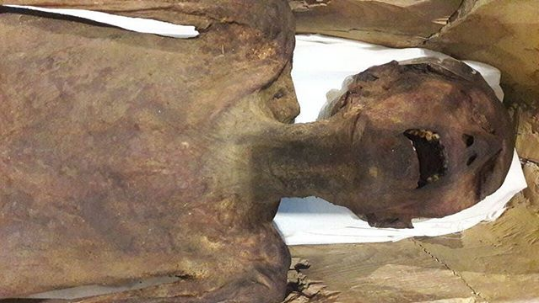Screaming mummy: Is the man with the agonising death face Ramses III's murderous son Prince Pentewere?
The mummy, with its face contorted in agony, was put on display this week at the Egyptian Museum.
Visitors to the Egyptian Museum in Cairo were in for a special treat this week after the Ministry of Antiquities decided to put the "screaming mummy" up on display as part of its plan to spotlight artefacts that up until now were kept away from the public.
Elham Salah, head of the museums sector at the ministry noted in a press release that this is the first time the mummy was being showed to the public since it was moved to the museum. Until this week, the remains were kept in its coffin in a storage area of the building.
The mummy is of special significance because of the expression of agony preserved on its face. Discovered in 1881, it was part of a large cache of tombs in the Deir El Bahri valley, near the Valley of The Kings.
This coffin stood out for the fact that is was plain and undecorated like the others which belonged to ancient Egyptian kings and queens including Rameses the Great, Seti I and Tuthmosis III. Considering there were no indications as to the identity of the mummy on or in the sarcophagus, it was labelled as "Unknown Man E".
When the mummy was unwrapped in 1886, scientists were shocked to find the state of the person interred. The man's face was distorted in a silent scream, lending him the nickname "screaming mummy".
For years, archaeologists have proposed theories as to the identity of the man, with one popular explanation suggesting that he may have been Prince Pentewere, the son of Pharaoh Ramses III and one of his wives, Tiye.
According to historic record, Pentewere unsuccessfully plotted to kill Ramses and take over the throne, despite the fact that the heir was supposed to be a son of the chief queen Iset Ta-Hemdjert. According to the Judicial Papyrus of Turin, Rentewere was made to take his own life after being brought to trial for the failed plot.
However, researchers believe the screaming mummy may have been buried alive or poisoned.

"Two forces were acting upon this mummy: one to get rid of him and the other to try to preserve him," Bob Brier, an archaeologist at the University of Long Island in New York who examined the body, told the National Geographic.
Considered the body was buried alongside other royals, it could be that of the prince. "We found this mummy is covered in sheepskin," Dr Zahi Hawass, secretary general of Egypt's Supreme Council of Antiquities noted.
"In the mind of the ancient Egyptian... to cover with sheepskin means he was not clean, he did something [bad] in his life.
"We'd never seen a mummy like this, suffering. It's not normal, and it tells us something happened, but we did not know exactly what."
At the same time, other archaeologists suggest that mummies are sometimes found with their jaws open which results in their heads falling back.
Most recently, 3D facial reconstruction and scanning have been able to dismiss certain older theories that the mummy belonged to Hittite prince who was supposed to marry Tutankhamun's widow Ankhesenamun. The features of the mummy were not typical of the Hittite people but similar to Egyptians, however, given that the man was buried in a nameless tomb; all these theories are only speculation.
"For some reason there was an attempt to make sure that he doesn't have an afterlife, and in another attempt somebody cares about him and tried to override that," Brier said of the man who continues to be an ancient Egyptian mystery.





















